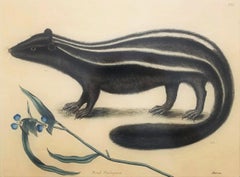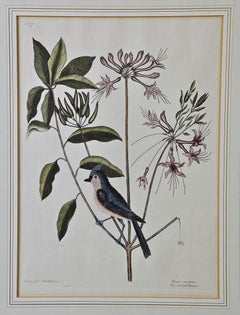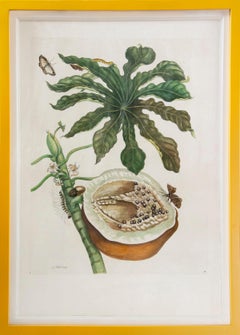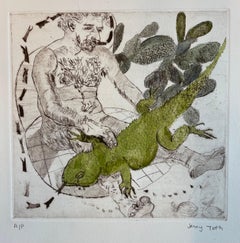Mark Catesby Animal Prints
English, 1682-1749
Mark Catesby (24 March 1683 – 23 December 1749) was an English naturalist. Between 1729 and 1747 Catesby published his Natural History of Carolina, Florida and the Bahama Islands, the first published account of the flora and fauna of North America. It included 220 plates of birds, reptiles, amphibians, fish, insects, mammals and plants. Mark Catesby's The Natural History of Carolina, Florida and the Bahama Islands is generally credited as the first published work to provide illustrations and descriptions of North American flora and fauna. From 1722-1726 Catesby, an English naturalist, ranged over South Carolina, Georgia and the Bahamas sketching and collecting specimens of native plants and animals. Little is known of Catesby's early life. He was born in eastern England in 1683. Although Catesby does not appear to have attended university or studied for the Bar, he was sufficiently educated to write clear English and Latin. His interest in and knowledge of plants may have derived from his uncle, who maintained a botanical garden. Catesby also appears to have benefited from an acquaintance with John Ray, a leading English naturalist of the 17th century and the co-author of an early classic study of birds. It is unclear when or how Catesby developed his skills as an artist.
Catesby's first visit to North America occurred in 1712 when he traveled to Williamsburg, Virginia, to live with his sister and her husband, who had settled there. During his seven-year stay, he explored the length of the James River sketching plants and collecting botanical samples. Upon Catesby's return to England in 1719, his work in Virginia drew the attention of several influential members of the Royal Society. And with their financial backing, Catesby returned to North America three years later, arriving in Charleston in May 1722. During his four-year stay, he traveled throughout South Carolina, coastal Georgia and to the Bahamas. The sketches and specimens Catesby gathered during his second North American trip formed the basis for The Natural History of Carolina, Florida and the Bahama Islands. Although most often found as a two-volume set, Catesby's Natural History was published in 11 discrete sections from 1734-1747 and sold by subscription. Although Catesby died in 1749, his work was republished in 1754 and again in 1771. Catesby's work predated the classification system developed by Swedish botanist Carl Linneaus. However, the 1771 edition, featured here, includes a catalog of the Linnean names for the plants and animals Catesby featured in Natural History.(Biography provided by Graves International Art)
to
2
1
1
2
Overall Height
to
Overall Width
to
2
1
1
1
1
2
2
8
289
248
211
125
1
1
1
1
1
Artist: Mark Catesby
Putorius & Pseudo Phalangium (The Pole-Cat) (Skunk) /// Mark Catesby Animal Art
By Mark Catesby
Located in Saint Augustine, FL
Artist: Mark Catesby (English, 1638-1749)
Title: "Putorius & Pseudo Phalangium (The Pole-Cat) (Skunk)" (Plate/Tab 62)
Portfolio: Natural History of Carolina, Florida & the Bahama Islands
*Monogram signed by Catesby in the plate (printed signature) lower right
Year: 1771-1810 (third edition)
Medium: Original Hand-Colored Etching on cream J. Ruse handmade paper
Limited edition: Unknown
Printer: Unknown
Publisher: Benjamin White, London, UK
Framing: Not framed, but recently matted in 100% cotton linen fabric matting with acid-free foam board backing
Matted size: 18.88" x 22.38"
Sheet size: 13.75" x 21.13"
Platemark size: 10.25" x 13.75"
Condition: UV staining to sheet and mat stain in margins. Some soft handling creases. In otherwise good condition
Very rare
Notes:
Provenance: private collection - Miami, FL. Comes from Catesby's famous two volume portfolio "Natural History of Carolina, Florida & the Bahama Islands" (1771-1810) (third edition), which consists of 220 hand-colored etchings. "J. Ruse 1800" watermark lower right.
Mark Catesby's The Natural History of Carolina, Florida and the Bahama Islands is generally credited as the first published work to provide illustrations and descriptions of North American flora and fauna. From 1722-1726 Catesby, an English naturalist, ranged over South Carolina, Georgia and the Bahamas sketching and collecting specimens of native plants and animals.
Skunks are North and South American mammals in the family Mephitidae. While related to polecats and other members of the weasel family, skunks have as their closest Old World relatives the stink badgers. The animals are known for their ability to spray a liquid with a strong, unpleasant scent.
Biography:
Mark Catesby (24 March 1683 – 23 December 1749) was an English naturalist. Between 1729 and 1747 Catesby published his Natural History of Carolina, Florida and the Bahama Islands, the first published account of the flora and fauna of North America. It included 220 plates of birds, reptiles, amphibians, fish, insects, mammals and plants. Mark Catesby's The Natural History of Carolina, Florida and the Bahama Islands is generally credited as the first published work to provide illustrations and descriptions of North American flora and fauna. From 1722-1726 Catesby, an English naturalist, ranged over South Carolina, Georgia and the Bahamas sketching and collecting specimens of native plants and animals. Little is known of Catesby's early life. He was born in eastern England in 1683. Although Catesby does not appear to have attended university or studied for the Bar, he was sufficiently educated to write clear English and Latin. His interest in and knowledge of plants may have derived from his uncle, who maintained a botanical garden. Catesby also appears to have benefited from an acquaintance with John Ray, a leading English naturalist of the 17th century and the co-author of an early classic study of birds...
Category
1770s Baroque Mark Catesby Animal Prints
Materials
Watercolor, Handmade Paper, Etching, Intaglio
18th Century Catesby Hand-colored Bird & Plant Engraving "The Crested Titmous"
By Mark Catesby
Located in Alamo, CA
A hand-colored copperplate engraving of a bird and plants by Mark Catesby (1683-1749) entitled "The Crested Titmous" from "The Natural History of Carolina, Georgia, Florida and the Bahama Islands", published in 1731. It depicts a small Crested Titmous bird, facing left, perched on the stem of a plant with clusters of mauve colored star-like flowers.
This original Catesby hand-colored engraving, on laid paper with a large central Fleur-de-Lys watermark, is presented in a cream color French mat. The mat measures 20" x 15.5" and the sheet measures 18.75" x 14.75".
Mark Catesby was born in England to a prosperous family, but he traveled to America, first to visit his sister and her husband in 1712. From 1712 to 1719 he explored America observing its birds and plants, taking notes, creating drawings and collecting specimens. He returned to England with this material and created more detailed drawings. His next visit to America 1722-1726 allowed for more detailed research. Upon his return to England he created his monumental and beautiful work "The Natural History of Carolina, Florida, and Bahama Islands", which was published in London in two folio volumes of 11 parts each consisting of 20 plates...
Category
Mid-18th Century Naturalistic Mark Catesby Animal Prints
Materials
Engraving
Related Items
Merian - A Group of Six Flowers, Insects and Fruits.
By Maria Sibylla Merian
Located in London, GB
[MERIAN, Maria Sibyl].
A Group of Six Flowers, Insects and Fruits.
The Hague, Gosse, 1719.
A group of six engravings by J. Mulder, P. Sluyter and D. Stoopendaal after Merian, with later hand-colour, of flowers, fruits and insects from Dissertatio de Generatione et Metamorphasibus Insectorum Surinamensium. Framed and glazed, overall dimensions: 38.2cm by 53.2cm.
Superb engravings which depict the metamorphoses of South American insects and the exotic plants on which they feed.
Maria Sybilla, daughter of the German engraver and publisher Matthias Merian, devoted herself to the study of European insects and their metamorphoses. As a result of the wealth of tropical varieties being brought back by the Dutch West Indies...
Category
1710s Naturalistic Mark Catesby Animal Prints
Materials
Engraving, Handmade Paper, Etching
Lizard Tongues and Tears, nude male and lizard, mostly monochromatic w green
By Jenny Toth
Located in Brooklyn, NY
The image is 8 x 8 inches, and the paper it is printed on is 15 x 13.5 inches. This is a quirky and tender image of a naked man sitting on the floor holding a giant iguana on his la...
Category
2010s Feminist Mark Catesby Animal Prints
Materials
Paper, Ink, Etching, Watercolor
H 15 in W 13.5 in D 0.25 in
Siberian eared Owl and Acadian Owl, 18th century bird engraving by John Latham
By John Latham
Located in Melbourne, Victoria
Copper-line engraving. 1781. From John Latham's 'General Synopsis of Birds' 1781-1785, and its Supplements. Plate number top left. Laid paper with watermark.
John Latham was the lea...
Category
Late 18th Century Naturalistic Mark Catesby Animal Prints
Materials
Engraving
Who Caire, Intaglio Etching by Jean Sariano
By Jean Sariano
Located in Long Island City, NY
Who Caire
Jean Sariano, Algerian/American (1943)
Date: 1979
Intaglio Etching, signed and numbered in pencil
Edition of 300
Size: 16 x 29 in. (40.64 x 73.66 cm)
Category
1970s Mark Catesby Animal Prints
Materials
Intaglio, Etching
Stanley Boxer Aquatint Intaglio Etching Elephant Herd Abstract Expressionist
By Stanley Boxer
Located in Surfside, FL
Elephants. 1979
edition 2/20
Hand signed and dated
Framed 24.5 X 28. Sheet 23 X 26
This is from a series of prints Boxer produced at Tyler Graphics between 1975 and 1979. Over this period, he created several series of intricately rendered figurative works, illustrating whimsical scenes featuring animals, plants and nubile winged figures. Boxer had, however, been making drawings of this nature throughout his career, and he insisted they were closely connected to his abstracts, made with similar gestures and motivation.
The Tate Museum received twenty-five of Stanley Boxer’s prints as a gift of Kenneth Tyler from Tyler Graphics, comprising a complete portfolio of Ring of Dust in Bloom, 1976, an incomplete portfolio of Carnival of Animals, 1979, and two individual prints. This work is from Carnival of Animals, a portfolio of fourteen intaglio prints on handmade paper. Tate holds eleven of the prints from this portfolio (Elephants, Swan and Fossils are not in Tate’s collection).
Stanley Boxer (1926-May 8, 2000) was an American abstract expressionist artist best known for thickly painted abstract works of art. He was also an accomplished sculptor and printmaker. He received awards from the Guggenheim Fellowship and the National Endowment for the Arts.
Boxer was born in New York City, and began his formal education after World War II, when he left the Navy and studied at the Art Students League of New York. He drew, painted, made prints, and sculpted. His work was recognized by art critic Clement Greenberg, who categorized him as a color field painter, A group that included
Barnett Newman, Clyfford Still, and Mark Rothko and was a form of Abstract Expressionism and later included Helen Frankenthaler, Ad Reinhardt, Kenneth Noland, Gene Davis, Jules Olitski, Raymond Parker and Morris Louis. Boxer himself was adamant in rejecting this stylistic label. Over the years, he remained loyal to the materially dense abstract mode on which his reputation rested.. Art critic Grace Glueck wrote "Never part of a movement or trend, though obviously steeped in the language of Modernism, the abstract painter Stanley Boxer was a superb manipulator of surfaces, intensely bonding texture and color."
In 1953 Boxer had his first solo exhibition of paintings in New York City, and showed regularly thereafter until his death. His paintings and sculpture were represented in New York City during the late 1960s through 1974 by the Tibor de Nagy Gallery, then by the André Emmerich Gallery from 1975 until 1993, and finally by Salander-O'Reilly Galleries until its demise in 2007. Richard Waller, director of the University of Richmond's Harnett Museum of Art, describes his evolution as an artist: You can see the shift from working with figurative imagery in the 1940s and early '50s to abstraction in the late '50s. The abstraction in the late '60s and '70s was more derived from color-field issues. In the 1980s, Boxer really hit his stride in larger works with lots of thick paint and splashes of color. He sold a lot, and his success in the art world in the 1980s gave him the freedom to do what he wanted to do most.
He was married to painter and artist Joyce Weinstein. The Boca Raton Museum of Art in Florida hosted an exhibition entitled Expanding Boundaries: Lyrical Abstraction Selections from the Permanent Collection.
At the time the museum issued a statement that said in part: "Lyrical Abstraction arose in the 1960s and 70s, following the challenge of Minimalism and Conceptual art. Many artists began moving away from geometric, hard-edge, and minimal styles, toward more lyrical, sensuous, romantic abstractions worked in a loose gestural style. These "lyrical abstractionists" sought to expand the boundaries of abstract painting, and to revive and reinvigorate a painterly 'tradition' in American art. "Characterized by intuitive and loose paint handling, spontaneous expression, illusionist space, acrylic staining, process, occasional imagery, and other painterly techniques, the abstract works included in this exhibition sing with rich fluid color and quiet energy. Works by the following artists associated with Lyrical Abstraction will be included: Natvar Bhavsar, Stanley Boxer, Lamar Briggs, Dan Christensen, David Diao, Friedel Dzubas, Sam Francis, Dorothy Gillespie, Cleve Gray, Paul Jenkins, Ronnie Landfield, Pat Lipsky, Joan Mitchell, Robert Natkin, Jules Olitski, Larry Poons, Garry Rich, John...
Category
1970s Abstract Expressionist Mark Catesby Animal Prints
Materials
Etching, Aquatint, Intaglio
His & Hers Prints, Pair of 18th Century Engravings of Male and Female Tapirs
By Jacques Eustache de Seve
Located in Harkstead, GB
A very attractive pair of engravings of Male and Female Tapirs.
Etching / engraving on hand laid paper.
Sheet size:(7,9 x 10,2 inch).
Image size: (6,3 x 7,9 inch).
Framed size: 15...
Category
18th Century Naturalistic Mark Catesby Animal Prints
Materials
Engraving
H 7.9 in W 10.2 in D 1 in
"Coyote Scratching His Fleas..." - Woodblock Print
By Daniel Stolpe
Located in Soquel, CA
Vibrant print of a coyote by Daniel Stolpe (American, 1939-2018). Titled, numbered ("Presentation Proof"), signed and dated along bottom edge. Presented in a black frame with a double mat. Sheet on verso with information about the piece, stating that only 5 Presentation Proofs were created, making this piece 1 of 5. Paper size: 24"H x 28"W.
(2018) Master artist and Native Images lithographer Dan "Coyote" Stolpe slipped out of his non-functioning body, and is running free at last and howling in the hills. Born and raised in Los Angeles, Dan's father introduced him to Native American teachers of Art and Culture through the Woodcraft Rangers, who influenced Dan for the rest of his life. "Everything was patterned after a tribal structure," Stolpe said. We learned about Indian life and lore and we had Indian guys teach us how to make Indian costumes and about Indian dance and drums. That's what got me interested."
Dan made his first drum when he was 14, and he was quietly playing that same drum during his final days of life.
Stolpe attended LA Co. Art Institute (OTIS) on scholarship until 1962, when he dropped out to Apprentice with artist Don La Viere Turner in Glendora, and then with Master Printer Joe Funk in Venice until 1966. Commissioned by the Smithsonian Institute, he moved to Washington DC to illustrate extinct birds...
Category
1980s Contemporary Mark Catesby Animal Prints
Materials
Ink, Woodcut, Rice Paper
Lesser White Throat, bird and nest engraving by John Latham
By John Latham
Located in Melbourne, Victoria
Copper-line engraving. 1781. From John Latham's 'General Synopsis of Birds' 1781-1785, and its Supplements. Plate number top left. Laid paper with water...
Category
Late 18th Century Naturalistic Mark Catesby Animal Prints
Materials
Engraving
Ape and Fox, antique animal fable etching by Samuel Howitt
By Samuel Howitt
Located in Melbourne, Victoria
Original antique etching by Samuel Howitt (1756-1822) . C1810. Published by Edward Orme.
An early 19th century etching by Howitt from a series depicting ...
Category
Early 19th Century Naturalistic Mark Catesby Animal Prints
Materials
Etching, Engraving
NOZEMAN & SEPP. A Pair of Ducks
By Cornelius Nozeman and Jan Christian Sepp
Located in London, GB
Dutch Birds
NOZEMAN, Cornelius & SEPP, Jan Christian.
Pair of Ducks: ANAS FERINA Mas and ANAS FERINA Foemina, from Nederlandsche Vogelen.
Jan Christian S...
Category
1770s Naturalistic Mark Catesby Animal Prints
Materials
Watercolor, Engraving, Handmade Paper
Blue Jays, Aquatint Etching by Martin Barooshian
By Martin Barooshian
Located in Long Island City, NY
Blue Jays
Martin Barooshian, American (1929–2022)
Date: circa 1981
Intaglio Etching and Aquatint, signed and numbered in pencil
Edition of 175, AP 25
Image S...
Category
1980s Mark Catesby Animal Prints
Materials
Aquatint, Intaglio, Etching
The Porculine Opossum (Bandicoot), Australia, engraving, 1795
Located in Melbourne, Victoria
'The Porculine Opossum' (Bandicoot)
Copper-line engraving with original hand-colouring. Circa 1795, by Richard Polydore Nodder (fl.1770 – 1800).
155mm by 125mm (platemark)
225mm by...
Category
Late 18th Century Naturalistic Mark Catesby Animal Prints
Materials
Engraving
Mark Catesby animal prints for sale on 1stDibs.
Find a wide variety of authentic Mark Catesby animal prints available for sale on 1stDibs. If you’re browsing the collection of animal prints to introduce a pop of color in a neutral corner of your living room or bedroom, you can find work that includes elements of orange and other colors. You can also browse by medium to find art by Mark Catesby in copper, engraving, etching and more. Not every interior allows for large Mark Catesby animal prints, so small editions measuring 16 inches across are available. Customers who are interested in this artist might also find the work of John Gould and Henry Constantine Richter, Francois Nicolas Martinet, and Samuel Howitt. Mark Catesby animal prints prices can differ depending upon medium, time period and other attributes. On 1stDibs, the price for these items starts at $750 and tops out at $1,900, while the average work can sell for $1,325.
Artists Similar to Mark Catesby
John Gould and Henry Constantine Richter



